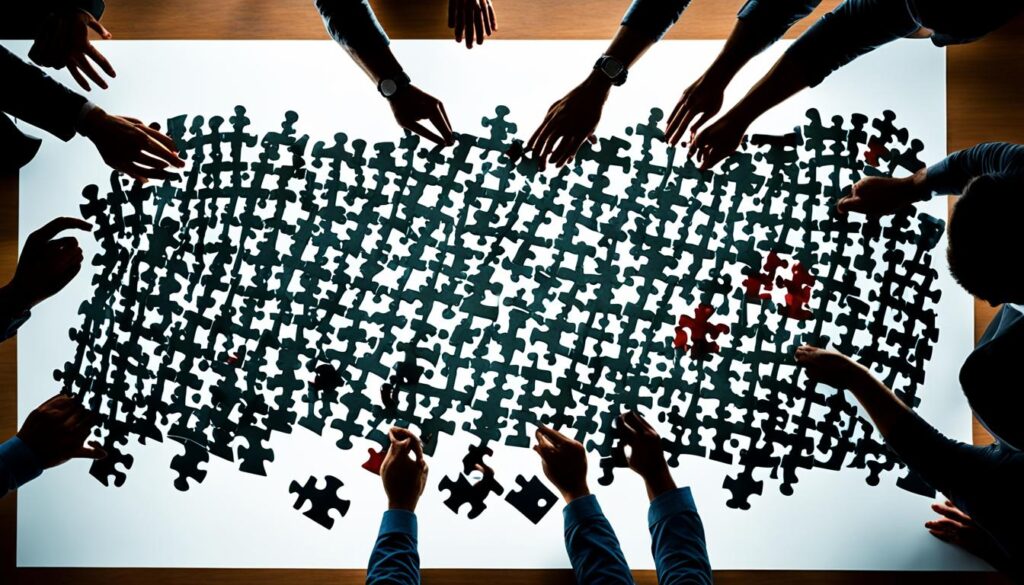Effective team dynamics are crucial for the success of any project. When team members communicate openly, collaborate efficiently, and stay organized, the project is more likely to run smoothly and yield positive results.
In this article, we will explore the significance of team dynamics and discuss examples of both positive and negative group dynamics. Additionally, we will provide effective strategies and tools to improve team dynamics and enhance project team performance.
Key Takeaways:
- Positive team dynamics lead to better job satisfaction, cost savings, and customer loyalty.
- Negative team dynamics can hinder workflow and decision-making.
- Leadership plays a crucial role in shaping team dynamics.
- Positive dynamics include open communication, collaboration, a shared vision, flexibility, and effective conflict resolution.
- To improve team dynamics, organizations can use team-building activities, open communication channels, clearly defined roles and responsibilities, and conflict resolution mechanisms.
Understanding Team Dynamics
Team dynamics play a critical role in project success. It refers to how individual team members interact with one another and how these interactions impact the overall performance of the team. By understanding team dynamics, organizations can harness the power of collaboration and synergy to drive project outcomes.
Positive team dynamics contribute to higher job satisfaction, cost savings, and improved customer loyalty. When team members collaborate effectively, share ideas, and work towards a common goal, they can achieve remarkable results. This leads to a positive work environment, increased productivity, and enhanced problem-solving capabilities.
“Positive team dynamics contribute to higher job satisfaction, cost savings, and improved customer loyalty.”
In contrast, negative team dynamics can hinder workflow and decision-making. When team members have poor communication, lack trust, or possess competing agendas, it can lead to conflicts and disruptions. Negative team dynamics create an environment where issues are not addressed promptly, leading to decreased productivity, project delays, and dissatisfaction among team members.
Leadership plays a crucial role in shaping team dynamics. A strong leader provides guidance, fosters open communication, and promotes a collaborative spirit within the team. Effective leaders resolve conflicts promptly, encourage a shared vision, and create an atmosphere of trust and respect. They understand the significance of positive team dynamics and work towards cultivating an environment that facilitates success.
To foster positive team dynamics, it is important to recognize the difference between positive and negative dynamics. By identifying potential signs of negative dynamics early on, leaders can take proactive measures to address them. This includes promoting open communication, encouraging team members to share their ideas and concerns, and implementing conflict resolution strategies.
Key Takeaways:
- Understanding team dynamics is crucial for project success.
- Positive team dynamics lead to higher job satisfaction, cost savings, and better customer loyalty.
- Negative team dynamics can hinder workflow and decision-making.
- Leadership plays a vital role in shaping team dynamics.
- Recognizing the difference between positive and negative dynamics is important.
By fostering positive team dynamics and addressing any negative dynamics, organizations can create a collaborative and productive work environment. In the next section, we will explore strategies to influence positive dynamics and mitigate negative dynamics within project teams.
Influencing Positive and Negative Dynamics
Positive team dynamics are essential for creating a productive and collaborative work environment. They foster open communication, a collaborative spirit, a shared vision, flexibility, and effective conflict resolution. These attributes contribute to a harmonious atmosphere where team members can thrive and achieve their goals. By promoting positive dynamics, teams can enhance the quality of work and project execution.
On the other hand, negative dynamics can disrupt team performance and hinder project success. Issues such as lack of trust, poor communication, competing agendas, avoidance of conflict, and resistance to change can create tension and hinder productivity. Leaders must be vigilant in identifying and addressing negative dynamics to ensure a smooth workflow and prevent potential roadblocks.
In order to influence positive dynamics within a team, open communication is key. Encouraging team members to express their thoughts, ideas, and concerns freely fosters a sense of belonging and psychological safety. This open exchange of information allows teams to collaborate effectively and make informed decisions.
Effective collaboration requires a shared vision. When team members align their goals and aspirations, they can work together towards a common objective, leveraging their individual strengths and skills. A shared vision promotes unity and a sense of purpose, driving the team towards success.
Flexibility and adaptability are also crucial in influencing positive dynamics. Embracing change and being receptive to new ideas and approaches allow teams to adapt to evolving circumstances and seize opportunities for innovation. This flexibility enables teams to overcome challenges and pivot as needed, ensuring project progress.
Conflict resolution is another significant aspect of influencing positive dynamics. Conflicts are inevitable in any team, and addressing them constructively ensures that they do not escalate and hinder productivity. By encouraging open dialogue, active listening, and a focus on finding mutually beneficial solutions, leaders can resolve conflicts and strengthen team cohesion.
Leaders must foster a collaborative spirit among team members, encouraging cooperation and collective problem-solving. This collaboration fosters creativity, out-of-the-box thinking, and diverse perspectives, leading to innovation and better outcomes.
Visual Representation
Below is a visual representation of the key elements that influence positive and negative team dynamics:

| Positive Dynamics | Negative Dynamics |
|---|---|
| Open communication | Lack of trust |
| Collaborative spirit | Poor communication |
| Shared vision | Competing agendas |
| Flexibility and adaptability | Avoidance of conflict |
| Effective conflict resolution | Resistance to change |
Understanding the factors that influence positive and negative dynamics can guide leaders in creating and maintaining a productive team environment. By fostering open communication, collaborative spirit, shared vision, flexibility, and effective conflict resolution, leaders can promote positive dynamics and ensure the success of their teams and projects.
How to Improve Team Dynamics Constructively?
Improving team dynamics is crucial for maximizing collaboration and achieving project success. By implementing a comprehensive approach and utilizing effective strategies, organizations can foster a positive and productive team environment. Here are some key strategies to improve team dynamics:
1. Team-Building Activities
Incorporate team-building activities into the work routine to foster trust, enhance communication, and strengthen relationships among team members. These activities can include team outings, retreats, or engaging in group exercises that promote collaboration and problem-solving skills.
2. Open Communication Channels
Establish open and transparent communication channels within the team. Encourage team members to share ideas, provide feedback, and express concerns. By creating a safe space for communication, conflicts can be addressed and resolved more effectively, leading to improved team dynamics.
3. Clearly Defined Roles and Responsibilities
Ensure that each team member has a clear understanding of their roles and responsibilities in the project. By defining individual responsibilities and expectations, potential conflicts and misunderstandings can be minimized, leading to smoother collaboration and increased productivity.
4. Conflict Resolution Mechanisms
Implement effective conflict resolution mechanisms to address any conflicts or differences that may arise within the team. Encourage open dialogue, active listening, and a focus on finding mutually beneficial solutions. Resolving conflicts in a constructive manner promotes healthy team dynamics.
5. Leveraging Technology
Utilize technology tools and platforms that enhance team collaboration and communication. Project management software, instant messaging apps, and video conferencing tools can facilitate seamless information sharing, improve coordination, and strengthen team dynamics, especially in remote or virtual work environments.

6. Recognizing and Rewarding Positive Behavior
Recognize and reward team members for their contributions and positive behavior. Celebrate achievements and milestones to foster a sense of accomplishment and motivation within the team. By acknowledging and appreciating individual and collective efforts, team dynamics can be further strengthened.
7. Continuous Learning and Development
Promote a culture of continuous learning and development within the team. Encourage team members to enhance their skills through training programs, workshops, and knowledge sharing sessions. By investing in personal growth, team members can bring new insights and perspectives to the team, leading to improved collaboration.
8. Feedback Mechanism
Establish a feedback mechanism that allows team members to provide constructive feedback to one another. Regularly solicit feedback on team dynamics, processes, and individual performance. This enables continuous improvement and ensures that any issues or concerns are addressed promptly.
9. Embracing Diversity
Recognize and embrace the diversity of your team members. Create an inclusive environment that values different perspectives, experiences, and backgrounds. Embracing diversity fosters innovation, creativity, and improved problem-solving, leading to stronger team dynamics.
10. Regularly Re-evaluate and Adjust
Regularly evaluate the effectiveness of your team dynamics strategies and make adjustments as needed. Use feedback, performance metrics, and team assessments to identify areas for improvement and implement changes accordingly. By continuously assessing and fine-tuning your approach, you can ensure that team dynamics remain positive and support project success.
By implementing these strategies and consistently prioritizing the improvement of team dynamics, organizations can create a collaborative and high-performing team that thrives in achieving project goals.
Conclusion
Team dynamics are a critical component of successful project management. Positive dynamics within a team foster collaboration, innovation, and efficient problem-solving, enabling organizations to achieve their project goals. On the other hand, negative dynamics can impede progress and hinder team performance.
To enhance project team performance, it is vital for organizations to prioritize the importance of team dynamics and employ effective teamwork strategies. This includes implementing team collaboration techniques, managing team conflicts, and cultivating leadership skills in team management.
One of the key pillars of positive team dynamics is effective communication. Open and transparent communication channels facilitate the exchange of ideas, enable swift decision-making, and build trust among team members. Additionally, having clearly defined roles and responsibilities ensures that each team member understands their contributions and responsibilities, minimizing confusion and enhancing overall team synergy.
Continuous learning and development are essential for improving team dynamics. Encouraging team members to embrace diversity, regularly evaluating and adjusting strategies, and providing feedback mechanisms help teams adapt to changing project needs and foster a culture of growth and collaboration. By actively focusing on team dynamics throughout the project lifecycle, organizations can maximize their team’s potential and achieve project success.
FAQ
Why are team dynamics important in project management?
Team dynamics are crucial in project management as they affect the overall performance and success of a project. Positive team dynamics lead to better collaboration, communication, and organization, resulting in higher job satisfaction, cost savings, and customer loyalty.
What are examples of positive team dynamics?
Positive team dynamics include open communication, collaboration, a shared vision, flexibility, and effective conflict resolution. These attributes contribute to a harmonious work environment and improve the quality of work and project execution.
What are examples of negative team dynamics?
Negative team dynamics include lack of trust, poor communication, competing agendas, avoidance of conflict, and resistance to change. These dynamics can disrupt team performance and hinder workflow and decision-making.
What strategies can improve team dynamics?
Strategies to improve team dynamics include team-building activities, open communication channels, clearly defined roles and responsibilities, conflict resolution mechanisms, leveraging technology, recognizing and rewarding positive behavior, continuous learning and development, feedback mechanisms, embracing diversity, and regularly evaluating and adjusting.
How do team dynamics affect project success?
Positive team dynamics foster collaboration, innovation, and efficient problem-solving, leading to project success. On the other hand, negative team dynamics hinder progress and can impede the achievement of project goals. By actively understanding and improving team dynamics, organizations can unlock their teams’ full potential and drive successful project outcomes.


